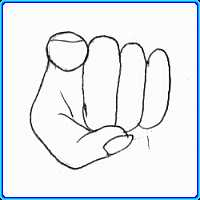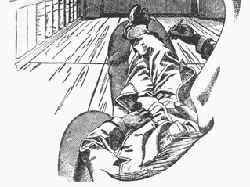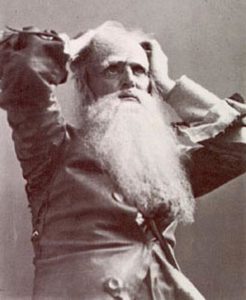Here are three imitation Douglas Harding experiments:
The Point That Doesn’t Exist
An experiment in headlessness by Shawn Nevins
Recently, a friend shared some of Douglas Harding’s experiments in headlessness. In one classic experiment, we pointed to a wall, then the floor, our feet, knees, stomach, chest, then pointed to the space out of which we were looking. If you are honest about what you see when you point at the place where you assume there is a head, you may be surprised by the change in perspective.
After the experiment, I somewhat absentmindedly pointed to the wall again, then — skipping the intervening steps — rotated my finger 180 degrees. I was immediately struck by the evidence presented by this simple movement: where was the point at which the first-person view (awareness) ended and “the other” or “the wall” began?
This experiment works best for those who have already experienced some of Harding’s experiments. Here it is in detail:
1. Point at a wall or any other object. Notice that the object seems to be “out there,” a thing apart from you.
 2. Next, slowly rotate your finger 180 degrees till you are pointing at that space from which you look out. That feature-less, all-encompassing space. Who you are at center, as Douglas would say.
2. Next, slowly rotate your finger 180 degrees till you are pointing at that space from which you look out. That feature-less, all-encompassing space. Who you are at center, as Douglas would say.
3. Finally, slowly rotate your finger back toward the wall. Watch very carefully and try to locate the point at which the “other” begins. Try to find the point at which you are no longer pointing at awareness, but are instead pointing at something else. Is it when you are not pointing at the “center” of your center? Is it when you point ten degrees off of dead center? twenty degrees? twenty-seven degrees?
Is there “the other” or does the first-person awareness extend outward and encompass all things? Try as you might, can you ever find where “you” ends and “other” begins? Isn’t pointing outward the same experience as pointing in?
Here is an extension to this experiment provided by a reader:
I followed your link to your discussion of Douglas Harding about pointing at the wall and then at– well, at what? I liked your suggestion to gradually move the finger that is pointing at your own face and see where it changes from pointing at “me” to pointing at “other.” When I was pointing the finger at my face, it was as if, in order for this to make sense, my consciousness had to re-locate to my finger so that my face could become “other.”
Then I did something weird… and I’d like to add this mind-blowing suggestion to this sequence: while pointing at your own face, get a real sense of being the finger pointing at that which seems to be “you.” Then with your other hand, point at the wall. You now have one hand pointing at your face and one hand pointing at the wall. Where in this are you? Is your awareness now located in your two hands?
Regards,
Sasha
Behind and Beyond
Another experiment in headlessness
Some friends and I had a retreat that included several of Douglas Harding’s experiments. I don’t know the name of the experiment, but it’s the one where each person draws their self from first person perspective. You draw exactly what you see of your self (not what you imagine) and all wind up with a headless drawing like (or somewhat like) this:

Next, we stood in a circle and each person placed their drawing in the circle, the drawing’s feet facing outward and the headless portion facing inward. What you discover is a representation of the Atman and Brahman: people emanating from the Void; sharing a common source. It is a powerful experiment, yet one we modified in two ways.
First, everyone turned around so we were still in a circle, but facing outward. We combined this with the inward pointing finger: looking inward, pointing at our true self, what was behind us but shared space? It was viscerally real, like experiencing Wren-Lewis’ description of the back of his head being sawn off and open to the dazzling dark.
Next, someone suggested we reverse the pictures so the feet faced inward and the headless portion faced outward. The people in the circle once again faced inward. For some, this variation was more suggestive of the true state of things. “Nothingness sitting on top of a body dropping out of a Void,” is how one friend described it.
These modifications of Harding’s work were not planned, inspiration just appeared in an open, playful mood and we “gave it a try.” I suggest others do the same, and keep sharing.
Heads Everywhere and Nowhere
A further experiment in headlessness
For some time, I couldn’t reconcile Harding’s teachings with the fact that I could feel my head. It seemed pretty obvious, on present evidence as Harding would say, that something was sitting on top of my shoulders. When doing Harding’s spectacles experiment, for example, the spectacles would eventually collide with something solid which seemed to be a head. Here’s an experiment for those of you who share my hard-headedness.
1. Close your eyes.
2. Hold out your left hand and make a fist. Focus attention on your fist. Now touch it with your other hand. Feel free to explore with your sense of touch.
3. Now touch the arm or seat of your chair. Give it a good feel.
4. Now touch your supposed head. Is there any difference in where these three feelings (touch experiences) occur? Is your head any more at the center of your being than the arm of your chair or your fist?
5. The evidence suggests to me that all these feelings occur in the same space. I either claim all touch experiences as my head or none of them. I’m either multi-headed or headless.
6. Just reading this won’t make any sense. You have to do the experiment.


Thank you. A lot of this spoke to me
Excellent inventions. Loved turning the pointing finger back slowly..which removes here/there line for me